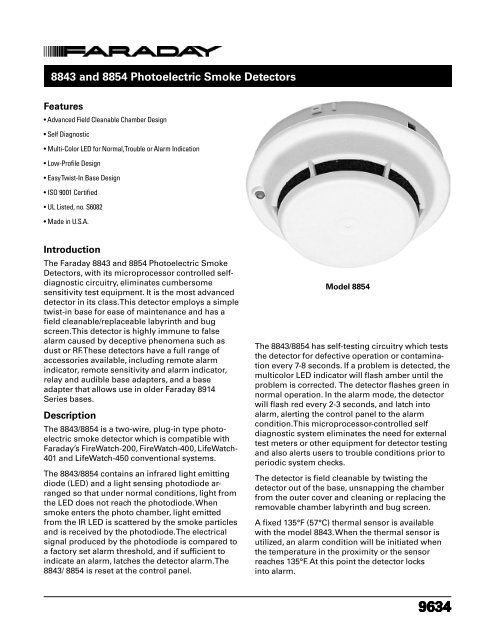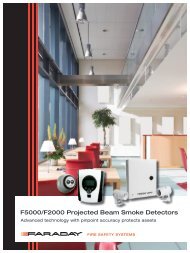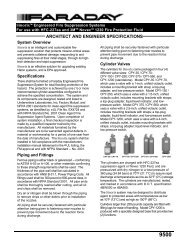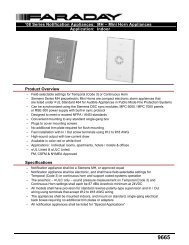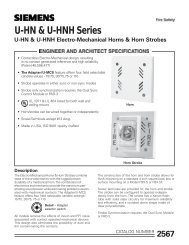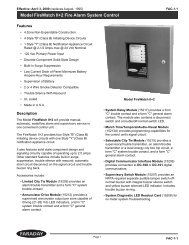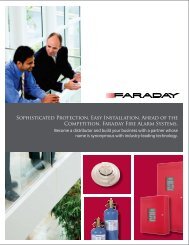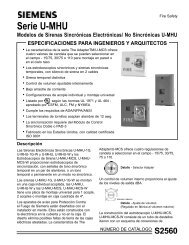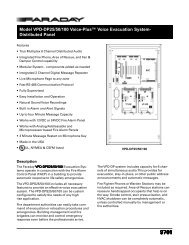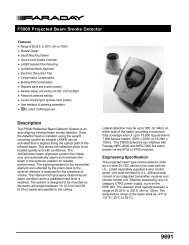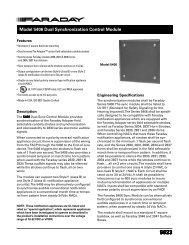8843 and 8854 Photoelectric Smoke Detectors - Siemens Building ...
8843 and 8854 Photoelectric Smoke Detectors - Siemens Building ...
8843 and 8854 Photoelectric Smoke Detectors - Siemens Building ...
- No tags were found...
Create successful ePaper yourself
Turn your PDF publications into a flip-book with our unique Google optimized e-Paper software.
<strong>8843</strong> <strong>and</strong> <strong>8854</strong> <strong>Photoelectric</strong> <strong>Smoke</strong> <strong>Detectors</strong>Features• Advanced Field Cleanable Chamber Design• Self Diagnostic• Multi-Color LED for Normal, Trouble or Alarm Indication• Low-Profile Design• Easy Twist-In Base Design• ISO 9001 Certified• UL Listed, no. S6082• Made in U.S.A.IntroductionThe Faraday <strong>8843</strong> <strong>and</strong> <strong>8854</strong> <strong>Photoelectric</strong> <strong>Smoke</strong><strong>Detectors</strong>, with its microprocessor controlled selfdiagnosticcircuitry, eliminates cumbersomesensitivity test equipment. It is the most advanceddetector in its class. This detector employs a simpletwist-in base for ease of maintenance <strong>and</strong> has afield cleanable/replaceable labyrinth <strong>and</strong> bugscreen. This detector is highly immune to falsealarm caused by deceptive phenomena such asdust or RF. These detectors have a full range ofaccessories available, including remote alarmindicator, remote sensitivity <strong>and</strong> alarm indicator,relay <strong>and</strong> audible base adapters, <strong>and</strong> a baseadapter that allows use in older Faraday 8914Series bases.DescriptionThe <strong>8843</strong>/<strong>8854</strong> is a two-wire, plug-in type photoelectricsmoke detector which is compatible withFaraday’s FireWatch-200, FireWatch-400, LifeWatch-401 <strong>and</strong> LifeWatch-450 conventional systems.The <strong>8843</strong>/<strong>8854</strong> contains an infrared light emittingdiode (LED) <strong>and</strong> a light sensing photodiode arrangedso that under normal conditions, light fromthe LED does not reach the photodiode. Whensmoke enters the photo chamber, light emittedfrom the IR LED is scattered by the smoke particles<strong>and</strong> is received by the photodiode. The electricalsignal produced by the photodiode is compared toa factory set alarm threshold, <strong>and</strong> if sufficient toindicate an alarm, latches the detector alarm. The<strong>8843</strong>/ <strong>8854</strong> is reset at the control panel.Model <strong>8854</strong>The <strong>8843</strong>/<strong>8854</strong> has self-testing circuitry which teststhe detector for defective operation or contaminationevery 7-8 seconds. If a problem is detected, themulticolor LED indicator will flash amber until theproblem is corrected. The detector flashes green innormal operation. In the alarm mode, the detectorwill flash red every 2-3 seconds, <strong>and</strong> latch intoalarm, alerting the control panel to the alarmcondition. This microprocessor-controlled selfdiagnostic system eliminates the need for externaltest meters or other equipment for detector testing<strong>and</strong> also alerts users to trouble conditions prior toperiodic system checks.The detector is field cleanable by twisting thedetector out of the base, unsnapping the chamberfrom the outer cover <strong>and</strong> cleaning or replacing theremovable chamber labyrinth <strong>and</strong> bug screen.A fixed 135°F (57°C) thermal sensor is availablewith the model <strong>8843</strong>. When the thermal sensor isutilized, an alarm condition will be initiated whenthe temperature in the proximity or the sensorreaches 135°F. At this point the detector locksinto alarm.9634
The <strong>8854</strong> utilizes the low-profile 8853 surfacemounting base which may be used with a 4 inchsquare or octagonal box, as well as a single-gangelectrical box. The <strong>8854</strong> has screw clamp terminalsfor easy wiring. The base has an optional concealedlocking device to prevent unauthorizeddetector removal.The <strong>8854</strong> is capable of operating both a remotelamp <strong>and</strong> a relay or audible base when used withLifeWatch-450 control panel, other panels will allowone accessory per detector. The 8848 Remote Sensitivity<strong>and</strong> Alarm indicator duplicates the multicolorLED of the detector at a remote location to indicatenormal operation (green), trouble or out of sensitivity(amber), or alarm (red) for detectors located in out ofthe way places such as duct detectors, under computerroom floors, or above suspended ceilings. The8849 is simply a remote red LED to indicate an alarmcondition of a detector.The <strong>8843</strong> <strong>and</strong> <strong>8854</strong> <strong>and</strong> all of the above listedaccessories are UL <strong>and</strong> ULC listed, <strong>and</strong> approvedby CSFM <strong>and</strong> NYMEA, <strong>and</strong> other local boardswhere applicable.Application DataThe <strong>8843</strong> <strong>and</strong> <strong>8854</strong> is fully compatible with otherFaraday low voltage detectors <strong>and</strong> may be intermixedon the same conventional zone circuit. The<strong>8843</strong> <strong>and</strong> <strong>8854</strong> are applicable to the 30 foot spacing(900 sq. ft.) as referred to in the National FireProtection Association St<strong>and</strong>ard 72. This detectorspacing, however, is based on ideal conditions <strong>and</strong>should be used only as a guide in planning detectorlayout. Do not mount detectors close to ventilationor air conditioning outlets that may movesmoke away from the detector. Exposed joists orceiling beams may also effect safe positioning ofsmoke detectors. It is m<strong>and</strong>atory that engineeringjudgement be applied regarding detector placement<strong>and</strong> spacing.Detector CleaningThe detector is field cleanable by twisting thedetector out of the base, unsnapping the chamberfrom the outer cover, without affecting sensitivecalibration <strong>and</strong> cleaning or replacing the removablechamber labyrinth <strong>and</strong> bug screen.Architect <strong>and</strong> Engineer SpecificationsThe photoelectric smoke detector shall be a plug-inunit which mounts to a twist/in base <strong>and</strong> shall beUL listed.The smoke detector shall operate on a two-wirecircuit <strong>and</strong> shall contain a multicolor LED indicatorindicating the detector is operational by flashinggreen, trouble by flashing amber, <strong>and</strong> alarm byflashing red. The detector shall be continually selftesting with visual operation indication <strong>and</strong> notrequire additional hardware or contact with thedetector for testing purposes.The detector shall allow for easy cleaning orreplacement of screens <strong>and</strong>/or chamber componentswithout affecting calibration.The base assembly into which the detector isinstalled shall be a twist/in design with screwclamp terminals. A security lock shall be installedin those areas where tamper resistant installation isrequired as indicated in the drawings.The detector or group of detectors shall require atwo-wire circuit of #18 AWG thermoplastic fixturewire enclosed in conduit, or #18 AWG limitedenergy shielded cable without conduit, if permittedby local building codes. All wiring shall be approvedfor fire alarm use <strong>and</strong> in compliance withnational <strong>and</strong> local codes. When required, the smokedetector shall contain a 135°F fixed temperatureself restoring heat sensor. Actuation of this deviceshall lock the detector alarm circuit.The detector shall be Faraday Model <strong>8854</strong> or Model<strong>8843</strong> with a 8853 surface mounting base.
Technical SpecificationsCurrent Requirements:Normal -100 uA peakAlarm - 40 mAVoltage Range:16 - 26.6 VdcOperating Temperature:32-102°F (0-39°C)Humidity:93% non-condensingShipping Weight:<strong>8843</strong>, 8 oz. approx.<strong>8854</strong>, 8 oz. approx.DimensionsWiringCaution:1. Do not use looped wire under base terminal 5.Break wire run to provide supervision of connection.2.When a remote relay is used to control a criticalsystem function, the relay <strong>and</strong> it’s associateddetector <strong>and</strong> optional module(s) must be the onlydevices on the initiating circuit.
Ordering Information<strong>Siemens</strong> <strong>Building</strong> Technologies, Inc.8 Fernwood Road • Florham Park, NJ 07932Tel: (973) 593-2600 • Fax: (973) 593-6670Web: www.faradayfirealarms.com10/05 2M SBT/IGWARNING- The information contained in this document is intended only as a summary <strong>and</strong>is subject to change without notice. The devices described in this document have specificinstruction sheets which cover various technical, limitation <strong>and</strong> liability information. Copiesof these instruction sheets <strong>and</strong> the General Product Warning <strong>and</strong> Limitations Document,which also contains important information, are provided with the product <strong>and</strong> are availablefrom the Manufacturer. Information contained in these documents should be consultedbefore specifying or using the product. For further information or assistance concerningparticular problems contact the Manufacturer.October 2005 - Supersedes sheet dated 12/03


